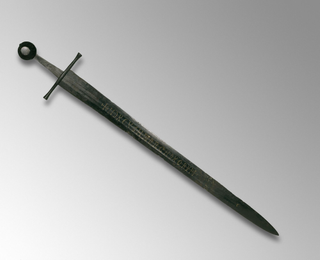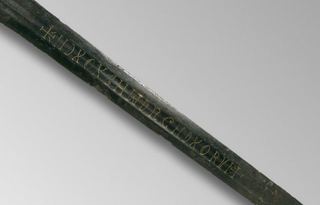Medieval Sword Carries Mysterious Inscription

A medieval sword inscribed with a mysterious message is stumping researchers and causing a stir among armchair historians.
The 13th-century weapon was found in the River Witham in Lincolnshire, in the United Kingdom, in 1825. It now belongs to the British Museum, but is currently on loan to the British Library, where it's being displayed as part of an exhibit on the 1215 Magna Carta.
The sword looks fairly ordinary at first glance. Weighing in at 2 lbs., 10 ounces (1.2 kilograms) and measuring 38 inches (964 millimeters) long, the weapon is steel, with a double edge and a hilt shaped like a cross. But on one side of the sword is a mysterious inscription, made by gold wire that has been inlaid into the steel, which reads, "+NDXOXCHWDRGHDXORVI+." [The 7 Most Mysterious Archaeological Finds on Earth]
What does this strange group of letters mean? No one knows for sure, according to the British Library, which recently posted information about the weapon on its website, along with a request for readers to help crack the seemingly incomprehensible code.
Is the message some kind of magical incantation, meant to empower the weapon's owner with mystical abilities during battle? Perhaps the inscription is a religious blessing, or maybe it's just the complicated signature of whoever forged the weapon. Those who read the British Library's blog post put these and many other theories forward regarding the sword's enigmatic message.

Dozens of commenters chimed in to help solve the mystery. And luckily, one of those commenters had a lot of insight into the history of inscribed swords in Europe. Marc van Hasselt, a graduate student of medieval studies at Utrecht University in the Netherlands, has studied similarly inscribed swords and said that these weapons were "all the rage" in 13th-century Europe. The British Library recently updated its blog post with more information from van Hasselt.
Wordy weaponry
Sign up for the Live Science daily newsletter now
Get the world’s most fascinating discoveries delivered straight to your inbox.
Many inscribed swords have been found in countries including Poland, France, Sweden, the Netherlands and the United Kingdom, making the River Witham sword "part of a large international family," according to van Hasselt.
In 2006, researchers from Uppsala University in Sweden (as well as several other institutions) started the Fyris Swords Project, a research project dedicated to figuring out the historical context in which these inscribed medieval swords were used.
The River Witham sword was forged in Germany, which was then the blade-making center of Europe, according to the British Museum. And pre-Christian Germanic tribesman inscribed runes onto their swords, axes and armor to "endow the items with magical powers," the Fyris Swords Project researchers wrote in a paper published in the journal Waffen- und Kostümkunde (Weaponry and Costumes) in 2009.
It's possible that this ancient tradition was carried over to Christian times and that the inscriptions on the blades were therefore meant to "invoke God’s holy name and his grace to gain support and protection in battle," according to the researchers.
Such swords were likely owned by wealthy warriors, according to the British Museum, which speculates that the River Witham sword belonged to a knight or some other rich individual who rode into battle during the crusades of the late medieval period. The British Museum also suggests that such swords may have been a part of the ceremony in which a man became a knight and vowed to defend the church.
Cracking the code
Even though historians are fairly certain why inscribed swords were popular in the medieval period and who owned them, they still aren't sure just what these swords actually say. Interpreting the inscriptions on the blades is like "trying to crack a mysterious code," according to the Fyris Swords Project researchers.
While historians aren't entirely sure what language the letters on the sword represent, they are fairly certain that the letters are a short-form version of Latin, according to van Hasselt, who said that Latin was the "international language of choice" in 13th-century Europe. The first two letters on the River Witham sword are ND, which van Hasselt said might be a kind of invocation that stands for "Nostrum Dominus (our Lord) or Nomine Domini (name of the Lord)."
The XOXcombination that follows could refer to the Holy Trinity of the Christian faith. And the two plus sign-shaped symbols before and after the inscription are likely Christian crosses, according to the Fyris Swords Project researchers.
This sort of speculation about what the sword's inscriptions might represent has been going on for more than a century (researchers have been publishing their interpretations of the inscriptions in the journal Waffen- und Kostümkunde since 1904). The variety of the letter sequences on the swords makes it clear that the inscriptions are not general statements (i.e., a standard blessing written out in short form). Quite the opposite is true, according to the researchers.
"[The] inscriptions (even though sometimes showing a constancy of letters) are extremely variable and appear to be very personal. One might say the individual secret of every sword bearer. It must have been a special dictum [saying] so obvious and so self-evident to him that it was not necessary to spell out its significant meaning," the researchers said.
Commenters on the British Library website have suggested a number of possible interpretations of the River Witham sword's inscription (which you can read under the library's blog post). But just as with the other inscribed swords found throughout Europe, it's unlikely that anyone will be able to say with complete certainty just what message this medieval sword conveys.
Follow Elizabeth Palermo @techEpalermo. Follow Live Science @livescience, Facebook & Google+. Original article on Live Science.

Elizabeth is a former Live Science associate editor and current director of audience development at the Chamber of Commerce. She graduated with a bachelor of arts degree from George Washington University. Elizabeth has traveled throughout the Americas, studying political systems and indigenous cultures and teaching English to students of all ages.
Most Popular


